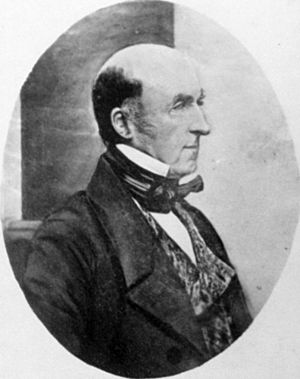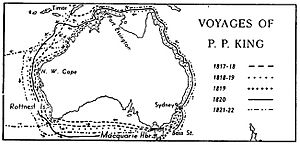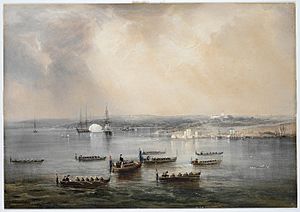Phillip Parker King facts for kids
Quick facts for kids
Phillip Parker King
|
|
|---|---|

Phillip Parker King
|
|
| Born |
Phillip Parker King
13 December 1791 |
| Died | 26 February 1856 (aged 64) North Sydney, Colony of New South Wales,
|
| Occupation | Naval Officer |
| Known for | Exploration of the coastline of Australia |
| Title | Rear Admiral |
Rear Admiral Phillip Parker King (born December 13, 1791 – died February 26, 1856) was an important explorer. He was a naval officer who mapped parts of the coasts of Australia and Patagonia (in South America). He was also a Fellow of the Royal Society, a famous group of scientists.
Contents
Early Life and Education
Phillip Parker King was born on Norfolk Island. His parents were Philip Gidley King and Anna Josepha King. He was named after his father's friend, Admiral Arthur Phillip. Arthur Phillip was the first governor of New South Wales and started the city of Sydney. This is why Phillip Parker King's first name is spelled differently from his father's.
When he was five years old, in 1796, Phillip was sent to England for school. In 1802, he joined the Royal Naval Academy in Portsmouth. He became part of the Royal Navy in 1807 and was made a lieutenant in 1814.
Exploring Australia's Coastline
Phillip Parker King was given a special job: to map the parts of the Australian coast that had not yet been explored by Matthew Flinders. Flinders was another Royal Navy officer who had already sailed around Australia.
King made four important trips between December 1817 and April 1822. His crew included 19 men, such as Allan Cunningham, a botanist (someone who studies plants), and John Septimus Roe, who later became the first Surveyor-General of Western Australia. An Aboriginal man named Bungaree also joined them.
The first three trips were on a small ship called the HMS Mermaid. The British Admiralty (the group in charge of the navy) wanted King to find out if there were any rivers that could lead into the middle of Australia. They also asked him to collect information about the land, animals, trees, minerals, weather, and the Indigenous peoples. They wanted to see if they could trade with them.
First Voyage (1818)
From February to June 1818, King surveyed the coast up to Van Diemen Gulf. This area is between the Northern Territory and Timor. During this trip, they met many Aboriginal Australians and saw proas (sailing boats) used by people from Makassar. In June, the Mermaid visited Timor before sailing back to Sydney, arriving on July 29.
Second Voyage (1818-1820)
In December 1818 and January 1819, King explored Macquarie Harbour in Van Diemen's Land (now Tasmania). In May 1819, he sailed north towards Torres Strait. King took John Oxley to the Hastings River in New South Wales. He then continued further up the coast to map the area between Cape Wessel (Northern Territory) and Admiralty Gulf (Western Australia). King returned to Sydney on January 12, 1820.
Third Voyage (1820)
On King's third trip, the Mermaid hit the ground on the Queensland coast. The crew did not realize how much damage was done until they had sailed around the tip of the Cape York Peninsula and across the northern coast to the Kimberley in Western Australia.
The ship started taking on water faster than the crew could pump it out. King had to find a safe place to fix the ship. He chose a spot about 600 kilometers (370 miles) north-east of where Broome is today. This place is now called Careening Bay on Coronation Island. "Careening" means deliberately grounding a ship to repair its bottom.
The crew spent 18 days fixing the ship. They did not meet any local Wunambal people, but they saw signs that the area was lived in. King wrote in his journal about the homes they saw. He described simple bark shelters on the beach and larger, stronger buildings on top of the hill. He also noticed leftover sago palm nuts, which were a common food along the coast.
King was worried about attacks from armed Makassan proas, as the Makassans harvested sea cucumbers and traded along the northern Australian coast. So, he ordered the ship's cannons to be set up on the beach for protection. They fixed the ship without any problems and sailed away in early October 1820. Before leaving, the ship's carpenter carved "Mermaid 1820" into an old boab tree, which can still be seen today.
Fourth Voyage (1821-1822)
King's fourth trip was on a larger ship called HMS Bathurst. The ship sailed north, through Torres Strait, and to the north-west coast of Australia, including the Dampier Archipelago. They also explored more of the west coast after visiting Mauritius.
Expeditions to South America
King was promoted to commander in July 1821 and returned to England in April 1823. Later, he commanded another survey ship, HMS Adventure. Along with HMS Beagle, he spent five years (1826–1830) mapping the complicated coasts around the Strait of Magellan at the southern tip of South America.
During this time, King collected many unique objects from the local tribes living in Tierra del Fuego. These objects were later given to the British Museum in London. Besides writing notes, King also made drawings and watercolor paintings to show what he saw. Some of these were later used in his books. He shared his findings at a meeting of the Royal Geographical Society in 1831.
His oldest son, also named Philip Gidley King, joined his father on these trips. He continued as a midshipman on HMS Beagle (1832–1836) for more mapping of Patagonia. On this journey, he was with the famous scientist Charles Darwin. King owned a property in Sydney where he hosted Charles Darwin in January 1836.
Later Life
When King returned to Australia in 1832, he became involved in politics. He was appointed to the New South Wales Legislative Council in 1839. In April of the same year, King became the resident commissioner of the Australian Agricultural Company, a job he held for ten years. He was again appointed to the Legislative Council in 1850 and was elected as a member for the Counties of Gloucester and Macquarie in 1851.
In 1855, King was promoted to Rear admiral on the retired list. He was also a member of the Royal Society, a group that promotes science.
Phillip Parker King died on February 26, 1856, in North Sydney.
Family
Phillip Parker King married Harriet Lethbridge in 1817. They had eight children together, including:
- Philip Gidley (1817–1904), who later became a member of the Legislative Council.
- John (1820–1895)
- (William) Essington (1821–1910)
- Rev. Robert Lethbridge (1823–1897), who was a principal at Moore Theological College.
- (Charles) Macarthur (1824–1903)
- Frederick (1825–1895)
- Arthur Septimus (1827–1899)
Legacy
Phillip Parker King and his crew made very important contributions to exploring and mapping Australia, especially the northern and western coasts. Because they were brave enough to sail very close to the shore, they were able to complete the valuable work of charting the entire coastline of Australia.
Recognition
- King was honored on a 2-pound postage stamp of Australia in 1963.
- The Australian native orchid Dendrobium kingianum was named after him.
- King Sound in the Kimberley region of Western Australia was named after him.
- Six species of reptiles are named in his honor, including the famous frill-neck lizard (Chlamydosaurus kingii). This lizard was first found by the botanist Allan Cunningham at Careening Cove during King's third journey in 1820.
Works
- King, P.P. (1827). Narrative of a Survey of the Intertropical and Western Coasts of Australia Performed between the Years 1818 and 1822.
- Extracts from a letter addressed by Capt. Philip Parker King, R.N., F.R.S. and L.S., to N.A. Vigors, Esq., on the animals of the Straits of Magellan. Zoological Journal London 3:422-32. 1828.
- Notes on birds collected by Capt. King in Chile. Proceedings of the Committee of Science and Correspondence of the Zoological Society of London, 1831: 29–30. 1831.
- King, P.P. and Broderip, W.J.. Description of Cirrhipedia, Conchifera and Mollusca, in a collection formed by the officers of H.M.S. Adventure and Beagle employed between the years 1826 and 1830 in surveying the southern coasts of South America, including the Straits of Magalhaens and the coast of Tierra del Fuego. The Zoological Journal, 5: 332–349. 1832.
- King, P.P. (1839). Narrative of the surveying voyages of His Majesty's Ships Adventure and Beagle between the years 1826 and 1836, describing their examination of the southern shores of South America, and the Beagle's circumnavigation of the globe. Proceedings of the first expedition, 1826-1830, under the command of Captain P. Parker King, R.N., F.R.S.
See also
 In Spanish: Phillip Parker King para niños
In Spanish: Phillip Parker King para niños
- King expedition of 1817
- European and American voyages of scientific exploration



